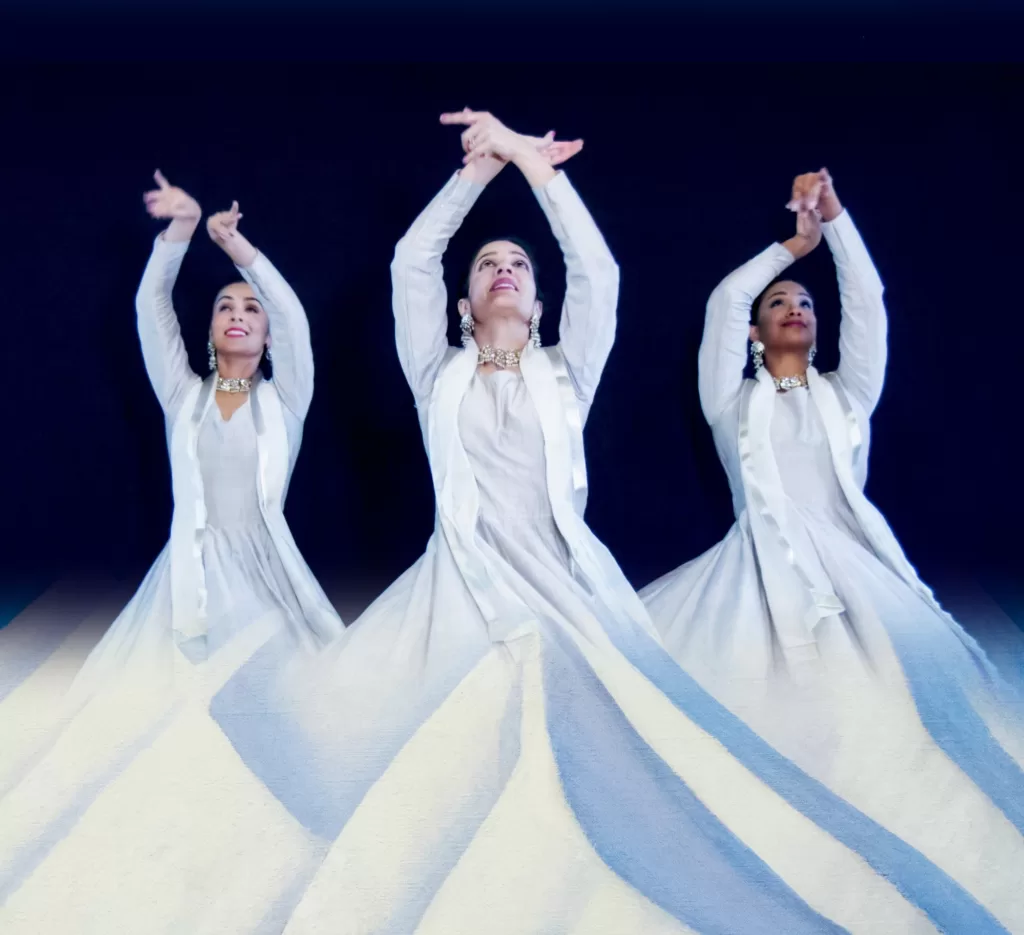What is the sound of snow?
Working in the form of Kathak, one is constantly interpreting life through the
sound of the bells…ghungroo…the hundreds of tiny bells wrapped meticulously
around the ankles of all of us Kathak dancers. The bells and the feet combine to
make a unique musical instrument that creates a dance of sound as well as
movement.
What is the Raga for the icy cold winter, or the soft deep snow, which soars but
also enfolds? These questions arose as I considered how to move into the piece.
Why does one embark on the journey of making a dance? I can only say: because
it’s there. But actually it is the journey that is worth making, to reach the goal of a
completed piece – culminating in a public performance in a cohesive design. It is
a process of exploring and reaching deeper into the practice.
This journey began in Toronto just recently in a studio in downtown Toronto.
One of many shared spaces which artists maintain for each other and the
community. It felt like angels. Four dancers gathered for five days, joined by our
musical collaborator Nick Storring. To say that Mr. Storring is a musical architect
would be a mere hint to his talent as a composer. But the group embarked on the
icy planes of his score to rediscover kathak on a slippery slope.
We began by listening. Dancers always want to move but I wanted us to discover
the geometry through sound. Certainly each snowflake has a music all its own
since it is a geometric shape. And from the sound came movement.
Are there angels in the snow? I think so.
Kathakvachan 101
Kathak from Katha meaning story. Katha kahe so kathak kahave. I have heard
this phrase from the time I first became interested in Kathak as art form. The
phrase is in a vernacular of Hindi from Uttar Pradesh, the home of Kathak. It
means ‘he who tells a story is a storyteller’, a kathak. The dance and the dancer
are one in the same word.
I have been fortunate to study at the feet of the great Kathavachaks of our time,
Pandit Birju Maharaj, his nephew, Guru Munna Lal Shukla, Dr. Maya Rao, Pandita
Rohini Bhate. All revered gurus whose deep study and creative genius enriched
the tradition of Kathak and Kathavachan. These great gurus have told countless
stories, many known and beloved, others new and strange. With a single gesture
or the arch of an eyebrow a river flows or lighting flashes through the sky. I have
reveled in the presence of countless performances by these great dancers
admiring the depth of their interpretation. Through apparently simple stories
they conjure divine wonder, deep emotion or even philosophical concepts. How
would it be possible for me to tell these stories in Canada, I always wondered?
So, after many many years I had the tremendous good fortune to do a true
Kathavachan in Canada. After nearly two years in the creation and evolution, and
several configurations, the City Room at the NAC in Ottawa was the site of a
Kathavachan, Canadian style. It could not have been more appropriate.
The poetry was by Mevlana Jellaluddin Rumi. A parable from Rumi’s Masnavi, it
is the Story of The Merchant and The Parrot. I opted for a format in which I told
the story in Rumi’s words translated into beautiful English. With a little practice I
was able to recite the lines while enacting the scenes with hand gestures.
I was fortunate to be accompanied by my dear friend S. Mushfiq Hashimi from
Afghanistan who sings Rumi’s lyrics in the original Persian. His music awakens
the true soul of the poetry and allows the dance to unfold. The apparent
simplicity of his composition is perfect for Kathavachan and belies the
tremendous philosophical and rhythmic complexity of the text.
Add to this the incredible tabla accompaniment provided by Kiran Morarji, from
Mississauga, but who migrated here with his family from Africa. With live tabla I
could explore the full dynamic of Kathak’s rhythmic repertoire. The parrot takes
flight and the merchant goes on a journey with incredible traditional Kathak
compositions played on tabla and interpreted by ghungroos and movement.
The total effect was true Kathavachan complete with narration, song, rhythm and
gesture. The audience was everyone who wandered into the City Room that day.
Children and elders, artists and tourists, people from many races and languages.
But for a time we were all in the dance together. Kathak was just its pure self…
telling a story from Persia about a Merchant that went to India… in English and
Persian… with musicians from Afghanistan and Africa and a dancer from Ottawa.
The Silk Road had truly reached Canada.

